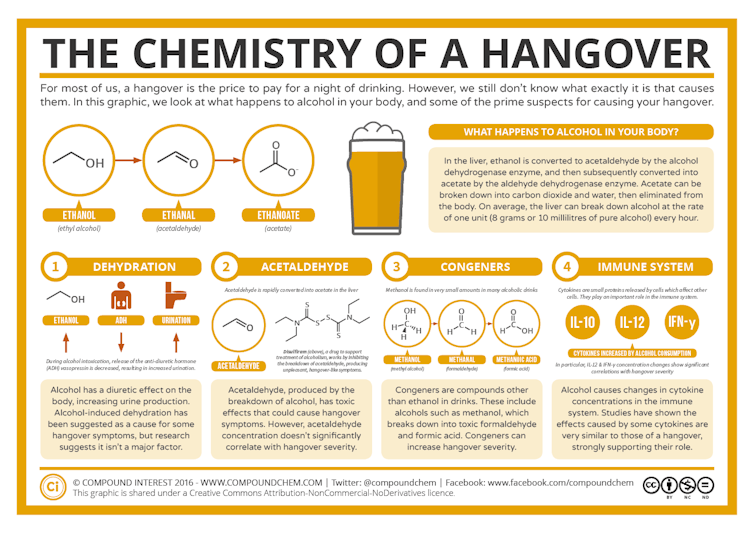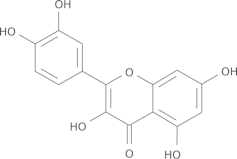Why does red wine cause headaches? Our research points to a compound found in the grapes’ skin
Opt for a lighter, cheaper red wine if you’re trying to dodge a headache this holiday season.

Medical accounts of red wine headaches go back to Roman times, but the experience is likely as old as winemaking – something like 10,000 years. As chemists specializing in winemaking, we wanted to try to figure out the source of these headaches.
Many components of red wine have been accused of causing this misery – sulfites, biogenic amines and tannin are the most popular. Our research suggests the most likely culprit is one you may not have considered.
The common suspects
Sulfites have been a popular scapegoat for all sorts of ailments since it became mandatory in the 1990s to label them on wines in the U.S. However, not much evidence links sulfites directly to headaches, and other foods contain comparable levels to wine without the same effects. White wines also contain the same amount of sulfites as red wines.
Your body also produces about 700 milligrams of sulfites daily as you metabolize the protein in your food and excrete it as sulfate. To do so, it has compounds called sulfite oxidases that create sulfate from sulfite – the 20 milligrams in a glass of wine are unlikely to overwhelm your sulfite oxidases.
Some people point the finger for red wine headaches at biogenic amines. These are nitrogenous substances found in many fermented or spoiled foods, and can cause headaches, but the amount in wine is far too low to be a problem.
Tannin is a good guess, since white wines contain only tiny amounts, while red wines contain substantial amounts. Tannin is a type of phenolic compound – it’s found in all plants and usually plays a role in preventing disease, resisting predation or encouraging seed dispersal by animals.
But there are many other phenolic compounds in grapes’ skin and seeds besides tannin that make it into red wines from the winemaking process, and are not present in white, so any of them could be a candidate culprit.
Tannin is also found in many other common products, such as tea and chocolate, which generally don’t cause headaches. And phenolics are good antioxidants – they’re unlikely to trigger the inflammation that would cause a headache.
A red wine flush
Some people get red, flushed skin when drinking alcohol, and the flushing is accompanied by a headache. This headache is caused by a lagging metabolic step as the body breaks down the booze.
The metabolism of alcohol happens in two steps. First, ethanol is converted to acetaldehyde. Then, the enzyme ALDH converts the acetaldehyde to acetate, a common and innocuous substance. This second step is slower for people who get flushed skin, since their ALDH is not very efficient. They accumulate acetaldehyde, which is a somewhat toxic compound also linked to hangovers.

So, if something unique in red wine could inhibit ALDH, slowing down that second metabolic step, would that lead to higher levels of acetaldehyde and a headache? To try to answer this question, we scanned the list of phenolics abundant in red wine.
We spied a paper showing that quercetin is a good inhibitor of ALDH. Quercetin is a phenolic compound found in the skins of grapes, so it’s much more abundant in red than white wines because red grape skins are left in longer during the fermentation process than white grape skins.
Putting enzymes to the test
Testing ALDH was the next step. We set up an inhibition assay in test tubes. In the assay, we measured how fast the enzyme ALDH breaks down acetaldehyde. Then, we added the suspected inhibitors – quercetin, as well as some other phenolics we wanted to test – to see whether they slowed the process.

These tests confirmed that quercetin was a good inhibitor. Some other phenolics had varying effects, but quercetin glucuronide was the winner. When your body absorbs quercetin from food or wine, most is converted to glucuronide by the liver in order to quickly eliminate it from the body.
Our enzyme tests suggest that quercetin glucuronide disrupts your body’s metabolism of alcohol. This disruption means extra acetaldehyde circulates, causing inflammation and headaches. This discovery points to what’s known as a secondary, or synergistic, effect.
These secondary effects are much harder to identify because two factors must both be in play for the outcome to arise. In this case, other foods that contain quercetin are not associated with headaches, so you might not initially consider quercetin as the cause of the red wine problem.
The next step could be to give human subjects two red wines that are low and high in quercetin and ask whether either wine causes a headache. If the high-quercetin wine induces more headaches, we’d know we’re on the right track.
So, if quercetin causes headaches, are there red wines without it? Unfortunately, the data available on specific wines is far too limited to provide any helpful advice. However, grapes exposed to the Sun do produce more quercetin, and many inexpensive red wines are made from grapes that see less sunlight.
If you’re willing to take a chance, look for an inexpensive, lighter red wine.
Andrew Waterhouse receives funding from associations supported by wine companies.
Apramita Devi does not work for, consult, own shares in or receive funding from any company or organization that would benefit from this article, and has disclosed no relevant affiliations beyond their academic appointment.
Read These Next
Tired of the same old Christmas songs? So were these countercultural carolers
Roots reggae, thrash metal and pop punk add new layers to familiar holiday tropes.
Measuring Colorado’s mountains one hike at a time
To most accurately measure mountain peaks, Eric Gilbertson lugs equipment all the way to the top.
Most normal matter in the universe isn’t found in planets, stars or galaxies – an astronomer explain
Most of the universe is made up of dark matter and dark energy. The majority of everything else is dispersed…





